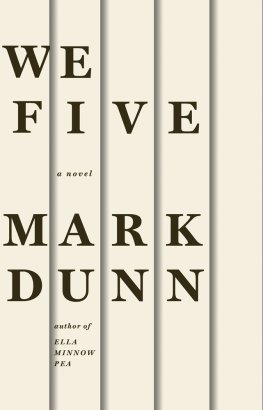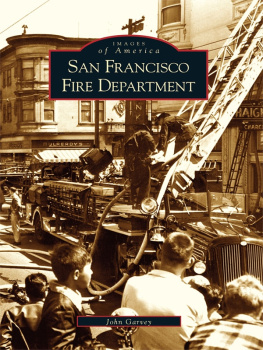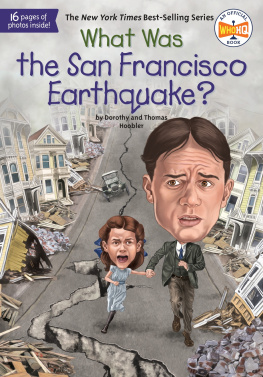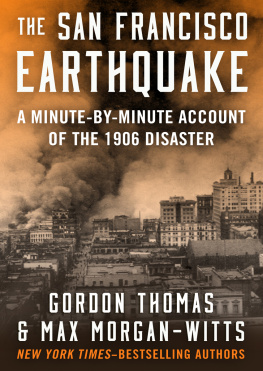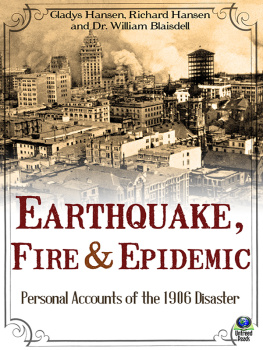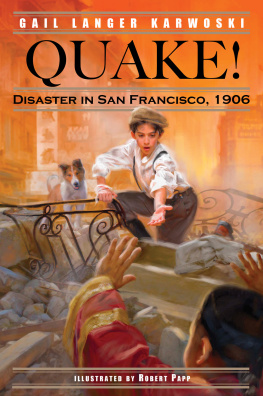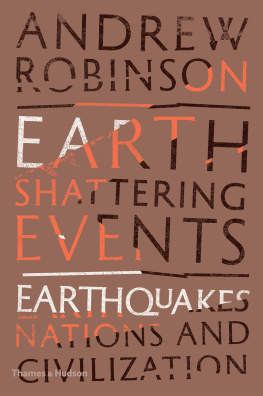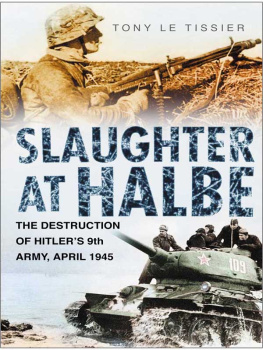

This Chronicle Books LLC edition published in 2006.
Copyright 1959 by W ILLIAM B RONSON
All rights reserved. No part of this book may be reproduced in any form without written permission from the publisher.
ISBN-10: 0-8118-5047-1
ISBN-13: 978-0-8118-5047-6 (pb)
ISBN-13: 978-1-4521-3372-0 (epub, mobi)
The Library of Congress has cataloged the previous edition as follows:
Bronson, William:
The earth shook, the sky burned
Reprint. Originally published: Garden City, N. Y.: Doubleday, 1959.
Includes index.
1. FiresCaliforniaSan Francisco. 2. EarthquakesCaliforniaSan Francisco.
3. San Francisco (Calif.)History. I. Title.
F869.8357B76 1986 979.4'61 85-31383
ISBN: 0-8118-1667-2
C HRONICLE B OOKS LLC
680 S ECOND S TREET
S AN F RANCISCO , C ALIFORNIA 94107
WWW.CHRONICLEBOOKS.COM
AUTHORS NOTES
I WASNT HERE in 1906, but as a child, a brilliant, blurred image of the San Francisco earthquake and fire was stirred up again and again by my elders untilas with some dreamsit was almost as if I had been. There is nothing extraordinary in my experience. Because the destruction of San Francisco was the biggest event in the lives of most of those who witnessed it, the story is as deeply etched in the memories of my contemporaries families as it is in mine.
My mother and father were too young to be in school in 1906. All Dad can remember is being hoisted up on someones shoulder to give him a better view of the burning city at night. The family lived in a shingled house on Monte Vista above Piedmont Avenue in Oakland, and it must have been from there that he saw the bright-as-day sky to the west. He doesnt remember the uphill neighbors chimney crashing into the house when the shock came, leaving a gaping two-story gash in the south wall, but my grandmother remembered it vividly and told me of the thunderous moment more than once. It was all very thrilling and dramatic, she wrote in reply to my questioning last spring, but Im sure our experience was very ordinary....
A couple of days after the quake, my grandmothers brother and his wife, accompanied by Jim, their Chinese cook, and five of their paying guests arrived from San Francisco for a long stay. Their house, which sat across Van Ness Avenue from St. Marys Cathedral, had been blown apart by one of the dynamiting teams in the effort to stop the fires western progress. Counting allmy grandparents; Dad and his seven brothers and sisters; Aunt Mamie, the housekeeper; and the eight refugees from across the Baynineteen people lived several months together, cramped but well, in the damaged house and the barn out in back. Jim, the cook, incidentally, saved nothing of his own when the order came to evacuate. But without anyone knowing, he packed a set of china plates he knew were dear to my great-aunt and carried them to Golden Gate Park that night. Nothing else was rescued from the house.
By another selfless act, valuable records belonging to my grandfather were saved from the fire. He had sold his book company in San Francisco a year or so before, but maintained a small office in his successors quarters in the Phelan Building. Watching the fire across the Bay spread uncontrollably, he assumed his account booksthe only record of a considerable amount owed to himwere consumed with the rest of downtown San Francisco. But fortunately, the young man who had bought the business made his way to the offices. Realizing he could save only a trifling few of the dictionaries and encyclopedias in his storerooms, he made a sling from a piece of rope and carted my grandfathers immense ledgers, one under each arm, to safety. Everything he left behind was destroyed later in the day.
Stories of the fire were repeated just as readily on the other side of my family. My mothers recollection is even hazier than my fathers, but her father, Bert Hempstead, helped organize and run the camp for Chinese refugees near Lake Merritt. For more than twenty-five years he served as constable in Oakland, and his experience in the camp was the beginning of a long friendship with the people of Oaklands Chinese colony. One of his major jobs was to suppress violence between rival tongs, but their affection for him never waned. I remember a long line of Chinese men standing in the afternoon glare on the day of his funeral in 1937, waiting to take a last look at their friend.
All of this is to point out the kind of recollection that has filtered down through a couple of generations in a very average Bay Area family. Some of the myths surrounding the disaster were mixed in with firsthand accounts, but this, too, is typical.
For every tale I heard while rooting around in search of background material, surely a thousand remain untold. But I have seen the earthquake and fire through the eyes of hundreds who were there, and for the sake of objectivity it may be better that I wasnt there myself. Conflicts in documentation, and there are many, sprang from the fact that a single reporter was physically unable to see more than a tiny part of what transpired, no matter how great his energy.
Like a powerful catalyst, the conflagration quickened the detail of human experience. Simple acts of kindness were framed forever in the Citys memory, and myths of impossible proportion which linger to this day grew out of the chaos. Most important, though, the people of San Francisco carried on with the vitality of youth and rebuilt their town in what even today seems an incredibly short time.
In forming this book, I have tried to catch the temper of the day and to record the events which made up the disaster and its aftermath. If it does this, and if it entertains you in the telling, I will have done what I wanted.
ACKNOWLEDGMENTS
I am, of course, indebted to many people for their assistance in the making of this volume. Some lent their aid in the normal routine of their work, and others spent precious hours of their own. All gave their help with great consideration and patience. My sincerest thanks...
TO MY FRIENDS for encouragement and valuable criticism: Nada Kovalik, Frances Coleberd, George Burkhardt, Martin Litton, Peter Waller, Clyde Childress, Rozalia De Kanter, Jack Pierce, Steven Johnson, Robert Cowgill, and Dagmar Johnson.
TO OUR FINE LIBRARIES and the librarians whose quiet competence makes research a pleasure: the library of the California Historical Society, the Stanford University Libraries, the University of Californias Bancroft Library and main collection, the Reference Division of the San Jose Public Library, the Palo Alto Public Library, the San Francisco Public Library, the library of the Society of California Pioneers, the Santa Rosa Public Library, and the Oakland Public Library.
TO ROY D. GRAVES , a grand San Franciscan, for his generous work in checking text and captions.
TO MY DEAR GRANDMOTHERS Mabel Knox Bronson and Mary Jane Hempsteadfor their loving help in the early stages.
TO THE PHOTO SOURCES whose files and albums yielded the heart of this book: the California Historical Society, the California Palace of the Legion of Honor, the Bancroft Library, the Bear Photo Service, Edward Zelinsky, the Society of California Pioneers, Mrs. Louise Hilbert, Harry Myers, the Morton-Waters Co., Burton F. Crandall, the San Francisco Chronicle, the San Francisco News, the Oakland Tribune, Mrs. T. T. Tourtillott, Roy D. Graves, the San Jose and Palo Alto Public Libraries, the U. S. Navy, Thomas C. Boyle, Stanford Universitys Branner Library and Stanford Collection, the San Francisco Chamber of Commerce, Paul Chaumont, and the Automobile Manufacturers Association.
Next page

